Want to know more about the Best Schools For Health Sciences Degrees in the US and make an informed decision? Here is a good place to start.
The quest for knowledge is a never-ending journey that we’re all on. If you’re passionate about health sciences, then you know that finding the right school can make all the difference. But with thousands of options, how do you know which ones are the best? Worry not.
We have compiled a list of the best schools for health sciences.
So get ready to discover the top institutions that help you achieve your career goals in the health sciences field.
Please note that schools are selected based on our criteria (at the end of the article), and ranked by the latest acceptance rate.
Table of Contents
#25. University of Texas, Dallas


- Acceptance rate: 79%
- Average entry score: 1220-1450 SAT
- Student-to-faculty ratio: 24 to 1
- Estimated cost of attendance (tuition and fees): $31,696-$56,908
- Average earning potential for graduates: $32,000 (College Simply)
One of the key strengths of UTD’s health sciences programs is their emphasis on hands-on learning. Students have access to cutting-edge technology and state-of-the-art facilities. These allow them to gain practical experience in a variety of healthcare settings.
The hands-on approach is essential for developing the skills and knowledge needed to succeed in healthcare. It also is a key reason why UTD graduates are highly sought after by employers.
In addition to its focus on practical learning, UTD’s health sciences programs are also supported by a talented and dedicated faculty. These experts bring a wealth of knowledge and experience to the classroom.
With their help, students gain a deep understanding of the healthcare industry and the skills and expertise needed to excel in their chosen field.
#24. Purdue University


- Acceptance rate: 69%
- Average entry score: 1170-1420 SAT or 25-33 ACT
- Student-to-faculty ratio: 14 to 1
- Estimated cost of attendance (tuition and fees): $24,390-50,000
- Average earning potential for graduates: $36,626 (College Factual)
Purdue has a stellar faculty and first-rate research facilities, which allow its students to learn from the best.
Plus, with their partnerships with major hospitals and health organizations, students get hands-on experience that’s hard to come by elsewhere.
With career services that help students find internships and job opportunities, as well as a strong alumni network that’s always willing to lend a helping hand, Purdue sets their students up for success.
Purdue’s health sciences programs are filled with passionate individuals who are committed to making a difference in the world. Whether it’s through volunteering or research, Purdue students and faculty are constantly striving to make the world a healthier and happier place.
#23. Ohio State University

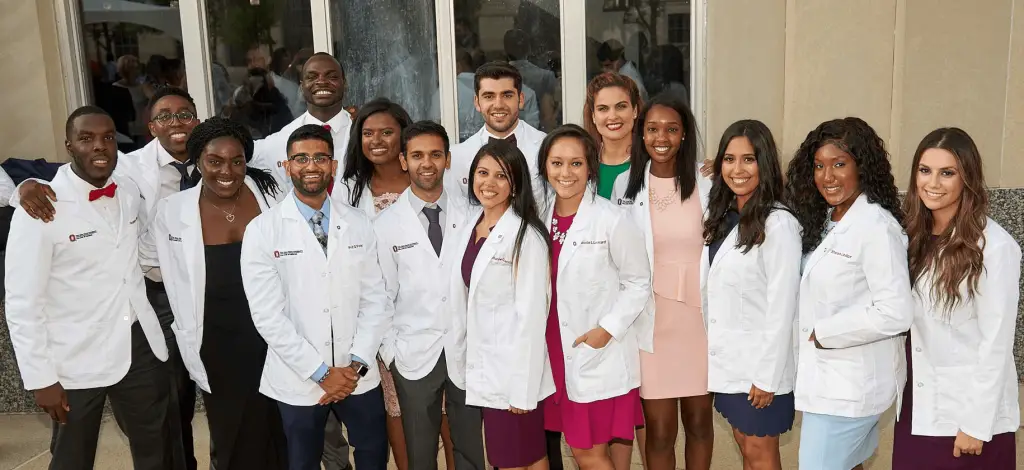
- Acceptance rate: 68%
- Average entry score: 1210-1430 SAT
- Student-to-faculty ratio: 18 to 1
- Estimated cost of attendance (tuition and fees): $29,368-$52,451
- Average earning potential for graduates: $64,900 (College Simply)
Ohio State University has got it all – brains, brawn, and a whole lot of Buckeye pride.
Their professors are experienced experts with a deep understanding of their subjects. They are keen to share their knowledge and experience with students. Also, they’re not afraid to get their hands dirty (or their lab coats stained) in the pursuit of scientific discovery.
And speaking of labs, OSU has some of the most advanced research facilities in the country. From cutting-edge technology to state equipment, this school is equipped to handle any experiment you can throw at it (just maybe don’t throw anything too explosive, okay? Safety first).
But OSU isn’t all work and no play. The campus is buzzing with energy, with plenty of opportunities to get involved in extracurricular activities and student organizations. Whether you’re into sports, music, or just hanging out with like-minded individuals, there’s something for you.
#22. University of Illinois Urbana-Champaign


- Acceptance rate: 63%
- Average entry score: 1200-1460 SAT
- Student-to-faculty ratio: 21 to 1
- Estimated cost of attendance (tuition and fees): $33,060-$50,510
- Average earning potential for graduates: $35,500 (College Simply)
The University of Illinois Urbana-Champaign’s health sciences faculty is stacked with some of the brightest minds in the biz.
These folks are like the Avengers of health science education—each one bringing their own unique skill set to the table. And just like the Avengers, they work together to create a super-powered learning experience for their students.
UIUC’s program also boasts cutting-edge facilities and resources that rival Tony Stark’s workshop. From state-of-the-art research labs to advanced simulation technology, students have access to everything they need to become the health science superheroes of tomorrow.
Similar articles like this:
- 25 Best Immunology Schools In The US
- 25 Best Microbiology Schools In The US
- 25 Best Education Schools In The US
#21. Pennsylvania State University


- Acceptance rate: 55%
- Average entry score: 1200-1400 SAT or 26-32 ACT
- Student-to-faculty ratio: 14 to 1
- Estimated cost of attendance (tuition and fees): $36,484-$54,062
- Average earning potential for graduates: $63,900 (College Simply)
PSU has state-of-the-art facilities that are equipped with the latest technology and equipment, giving students a chance to get hands-on experience in a real-world setting.
But what really sets PSU apart is their commitment to their students’ success. From day one, they provide their students with the resources and support they need to thrive.
Whether it’s through one-one advising, career counseling, or access to internships and research opportunities, PSU goes above and beyond to make sure their students are set up for success.
#20. University of South Florida


- Acceptance rate: 49%
- Average entry score: 1160-1320 SAT
- Student-to-faculty ratio: 22 to 1
- Estimated cost of attendance (tuition and fees): $23,866-$34,780
- Average earning potential for graduates: $29,000 (College Simply)
Besides offering a healthy academic environment, USF has a number of facilities and services that are available to students.
This includes a full-service library, classrooms and lecture halls, computer labs, and student lounges. Health sciences students enjoy the use of these facilities to improve their learning experience and prepare them for the workforce.
As part of its mission to provide students with an exceptional educational experience, USF has established a number of research initiatives.
These include ongoing studies in fields such as oncology and immunology. They impart students with the skills they need to be successful in their future careers.
#19. Clemson University


- Acceptance rate: 49%
- Average entry score: 1230-1400 SAT or 27-32 ACT
- Student-to-faculty ratio: 17 to 1
- Estimated cost of attendance (tuition and fees): $34,096-$57,088
- Average earning potential for graduates: $27,100 (College Simply)
Clemson University has earned a reputation for excellence in health sciences because of its wide variety of programs, experienced faculty members, state-of-the-art facilities, and supportive services.
The university offers nursing, public health, health administration, and other health sciences programs. Its faculty members are knowledgeable and dedicated to teaching students. They are also well-published and involved in research.
The university’s facilities include modern laboratories, sophisticated equipment, and specialized classrooms. These facilities provide hands-on learning opportunities. Clemson’s support services help students succeed socially, emotionally, and academically.
#18. University of Minnesota, Crookston


- Acceptance rate: 48%
- Average entry score: 1030-1190 SAT or 18-25 ACT
- Student-to-faculty ratio: 16 to 1
- Estimated cost of attendance (tuition and fees): $25,940
- Average earning potential for graduates: $45,600 (College Simply)
You’re standing in the midst of the glorious, rolling prairies of Minnesota, taking in the fresh, crisp air as you gaze out at the endless expanse of nature around you. Suddenly, a thought strikes you: “Where could I possibly go to pursue my health sciences amidst all beauty?”
The answer lies in the heart of the prairies themselves: the University of Minnesota, Crookston. Here, you’ll find a place where innovation and excellence in health sciences come together to create an unparalleled educational experience.
With top-notch faculty and cutting-edge research facilities, the University of Minnesota, Crookston, is a hub for students who are driven to excel in the field of health sciences.
But there’s more to the academic experience here than just a challenging curriculum. The campus itself is a haven for those who love the great outdoors. From hiking trails to wildlife preserves, there’s no shortage of ways to connect with nature and stay active while pursuing your degree.
Similar articles like this:
- 25 Best Material Science Schools In The US
- 25 Best Schools For Math In The US
- 25 Best Medical Schools In The US
#17. University of Georgia


- Acceptance rate: 48%
- Average entry score: 1250-1460 SAT
- Student-to-faculty ratio: 17 to 1
- Estimated cost of attendance (tuition and fees): $27,958-$46,998
- Average earning potential for graduates: $42,400 (College Simply)
The sun is shining down on the sprawling green campus, and students bustle to and fro, their backpacks heavy with textbooks and determination. You take a deep breath of the fresh Georgia air, and suddenly, you feel inspired.
Motivated to learn, to grow, and to become the best version of yourself. That’s the magic of the University of Georgia, where health science degrees reign supreme.
UGA’s professors are the cream of the crop, with years of experience, research, and innovation under their belts. They don’t just teach students. These professionals inspire them to push the boundaries of what’s possible in the health science field.
From cutting-edge research to hands-on learning opportunities, UGA’s faculty are the heart and soul of the program.
UGA is also known for its close-knit community. There’s a sense of support permeating every corner of the campus. Students work together, learn together, and grow together – and that’s what makes UGA such a special place.
#16. University of Florida
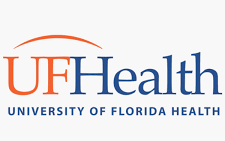

- Acceptance rate: 31%
- Average entry score: 1290-1460 SAT
- Student-to-faculty ratio: 18 to 1
- Estimated cost of attendance (tuition and fees): $21,430-$43,708
- Average earning potential for graduates: $67,100 (College Simply)
The University of Florida offers a wide range of health science degrees and programs, making it one of the best schools for people seeking to obtain such training.
For example, the Bachelor of Health Science (BHS) degree includes didactic and experiential activities for students to learn the foundation skills necessary for success in a dynamic health environment.
This degree will help students to find solutions to current and emerging health issues through transdisciplinary coursework, professional training, and more.
Backed by a nationally recognized faculty and staff, the University of Florida is a great place to earn a BHS degree. The university offers students many opportunities to engage in clinical experiences and network with professionals in their fields.
#15. University of Richmond


- Acceptance rate: 31%
- Average entry score: 1310-1490 SAT or 31-34 ACT
- Student-to-faculty ratio: 8 to 1
- Estimated cost of attendance (tuition and fees): $74,590
- Average earning potential for graduates: $48,400 (College Simply)
The University of Richmond boasts professors who are walking encyclopedias of health knowledge. They know their stuff and are not afraid to share it with their students.
This institution also has modern facilities and cutting-edge technology that would make even the most tech-savvy health jealous. From advanced labs to top-of-the-line equipment, the University of Richmond is serious about staying ahead of the game.
The school’s collaboration with the biggest names in the health industry brings their students the most up-to-date and relevant information.
#14. New York University

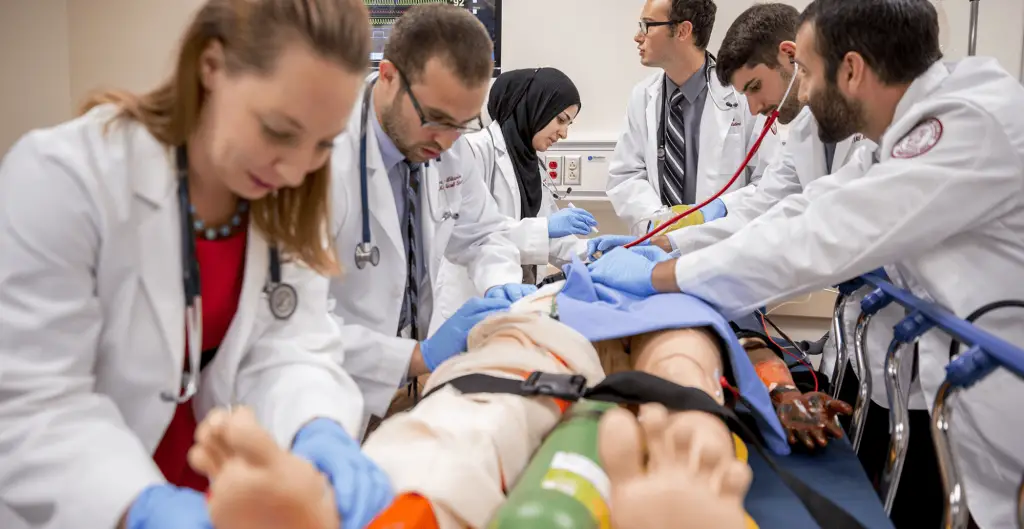
- Acceptance rate: 21%
- Average entry score: 1455 SAT or 33 ACT
- Student-to-faculty ratio: 8 to 1
- Estimated cost of attendance (tuition and fees): $80,878
- Average earning potential for graduates: $54,870 (College Factual)
New York University’s health sciences programs are considered some of the best due to their strong commitment to research, innovation, and interdisciplinary education. The university offers a wide range of programs that attract top-notch faculty and students from all over.
New York University’s health sciences programs stand out for their emphasis on interdisciplinary collaboration. Besides fostering a culture of innovation and creativity, this approach prepares students for the real-world challenges they will face in their careers.
Another factor contributing to NYU’s success is their state-of-the-art research facilities and resources. The university invests heavily in research. Their faculty members are at the forefront of many groundbreaking discoveries and advancements in healthcare.
Students benefit from this by having access to cutting-edge research opportunities and by learning from some of the best and brightest minds in the field.
Similar articles like this:
- 25 Best Multidisciplinary Schools In The US
- 25 Best Gerontology Schools In The US
- 25 Best Nursing Schools In The US
#13. Boston University


- Acceptance rate: 20%
- Average entry score: 1310-1500 SAT
- Student-to-faculty ratio: 11 to 1
- Estimated cost of attendance (tuition and fees): $79,606
- Average earning potential for graduates: $66,400 (College Simply)
Boston University, through its health science program, offers a comprehensive curriculum that provides students with a strong foundation in the field. The faculty is made up of experienced professionals committed to providing students with an exceptional education.
Students also have access to research labs and internships at some of the country’s top hospitals and medical centers. The university also has a strong support system for students who need additional assistance. These include tutoring, counseling, and career services.
Boston University’s location in the heart of Boston provides students access to various healthcare organizations and opportunities to network with professionals in the field.
#12. Washington University in St. Louis


- Acceptance rate: 16%
- Average entry score: 1480-1560 SAT
- Student-to-faculty ratio: 9 to 1
- Estimated cost of attendance (tuition and fees): $30,640-$58,470
- Average earning potential for graduates: $52,100 (College Factual)
The University of Washington in St. Louis offers a comprehensive range of programs tailored to meet the needs of students who are interested in pursuing careers in the health sciences.
This university has a strong reputation for producing groundbreaking research in a range of health-related fields.
Besides the institution’s research prowess, the University of Washington in St. Louis also boasts resources designed to support students in their pursuit of academic and professional success.
From cutting-edge labs and technology to a wide range of clinical and fieldwork opportunities, they need to excel.
#11. Johns Hopkins University
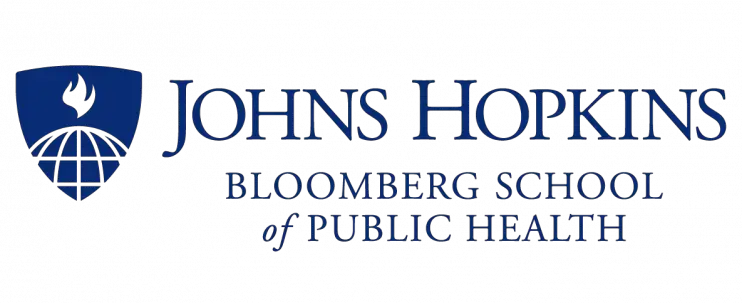

- Acceptance rate: 11%
- Average entry score: 1515 SAT or 35 ACT
- Student-to-faculty ratio: 7 to 1
- Estimated cost of attendance (tuition and fees): $60,480
- Average earning potential for graduates: $93,100 (College Simply)
There’s something special about Johns Hopkins University. Maybe it’s their cutting-edge research or their world-renowned faculty, but whatever it is, it’s working.
When it comes to health sciences, Johns Hopkins University is a true heavyweight in the ring. This prestigious institution has been at the forefront of cutting-edge medical research and innovation for over a century.
From their world-renowned faculty to their state-of-the-art facilities, everything about their health sciences programs screams “top of the line.”
#10. University of Pennsylvania

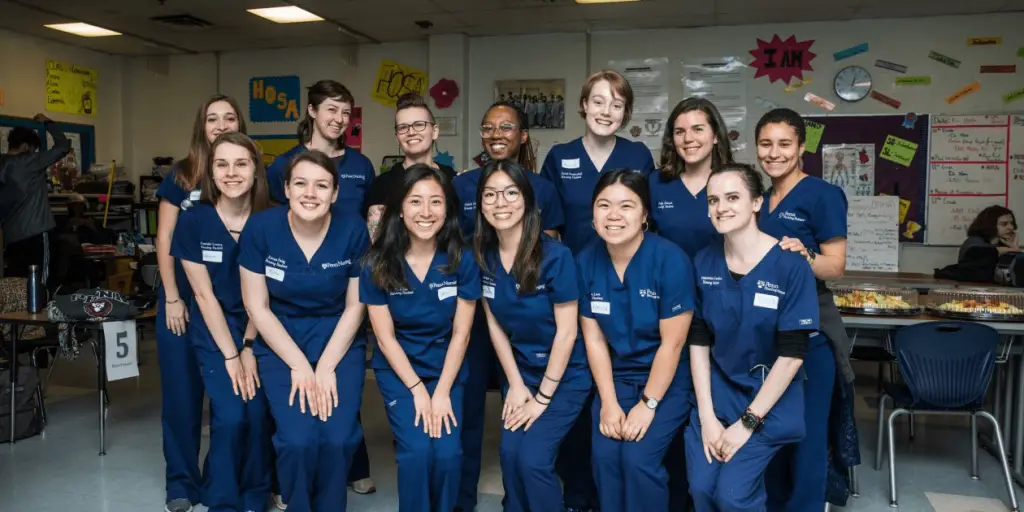
- Acceptance rate: 9%
- Average entry score: 1515 SAT or 34 ACT
- Student-to-faculty ratio: 7 to 1
- Estimated cost of attendance (tuition and fees): $63,452
- Average earning potential for graduates(Master’s Degree): $197,100 (College Simply)
The University of Pennsylvania’s health sciences programs is renowned for their exceptional faculty, rigorous research, and modern facilities.
This university houses distinguished schools of medicine, nursing, dental medicine, and veterinary medicine, offering various degree programs and specializations to students.
UPenn’s focus on interdisciplinary collaboration and innovation has led to groundbreaking discoveries and improvements in healthcare. The students in these programs receive excellent clinical training and research opportunities, preparing them for prosperous careers in healthcare.
What’s it like to study at UPenn?
Similar articles like this:
- 25 Best Schools For Neuroscience In The US
- 25 Best Pharmaceutical Sciences Schools In The US
- 25 Best Astronomy Schools In The US
#9. Northwestern University


- Acceptance rate: 9%
- Average entry score: 1430-1550 SAT
- Student-to-faculty ratio: 6 to 1
- Estimated cost of attendance (tuition and fees): $62,391
- Average earning potential for graduates: $35,057 (College Factual)
Northwestern University’s health science degree programs are like a unicorn in the field of horses. They stand out amongst the pack with their innovative curriculum, world-renowned faculty, and state-of-the-art facilities.
These programs are designed to push the boundaries of traditional healthcare education by incorporating cutting-edge technology and research into every aspect of the curriculum.
It’s not just about the flash and fancy gadgets. Northwestern’s health science programs are built on a foundation of excellence, with a focus on developing critical thinking skills, fostering collaboration, and instilling a deep sense of empathy in all their students.
From day one, students are challenged to think
outside the box, explore new avenues of thought, and tackle real-world problems in ways that make a difference in people’s lives.
What’s it like to study at Northwestern University?
#8. California Institute of Technology


- Acceptance rate: 8%
- Average entry score: 1530-1560 SAT
- Student-to-faculty ratio: 3 to 1
- Estimated cost of attendance (tuition and fees): $60,864
- Average earning potential for graduates: $69,000 (College Factual)
Caltech’s health sciences programs are renowned for their academic rigor, innovative approach, and commitment to producing the next generation of healthcare leaders.
It should come as no surprise that Caltech’s health sciences programs continue to attract a diverse group of students from all over the world.
The institute’s unique approach to health sciences education ensures that students are equipped with the knowledge, skills, and experience necessary to excel in their careers.
Caltech’s interdisciplinary health sciences approach allows students to receive a broad education in the field. By engaging students in solving real-world health problems, this approach also enables them to explore innovative solutions.
What’s it like to study at Caltech?
#7. Duke University


- Acceptance rate: 8%
- Average entry score: 1520 SAT or 35 ACT
- Student-to-faculty ratio: 8 to 1
- Estimated cost of attendance (tuition and fees): $63,054
- Average earning potential for graduates: $93,000 (College Simply)
Duke University is renowned for its commitment to providing a high-quality community health education in a respectful and professional environment. Its well-being and support services resources are designed to ensure that students receive the best possible care and support.
Plus, Duke is a leader in interdisciplinary collaboration. This allows for the translation of fundamental scientific discoveries to improve human health.
Health sciences programs at Duke also benefit from the university’s location in the Research Triangle. This is home to some of the world’s most prominent biomedical and pharmaceutical companies.
What’s it like to study at Duke University?
#6. Yale University


- Acceptance rate: 7%
- Average entry score: 1520 SAT or 34 ACT
- Student-to-faculty ratio: 6 to 1
- Estimated cost of attendance (tuition and fees): $62,250
- Average earning potential for graduates: $75,393 (College Factual)
Yale University boasts renowned professors who are experts in their respective fields, offering students the opportunity to learn from the best minds in healthcare. Yale’s state-of-the-art research facilities provide students with the necessary resources and tools to conduct groundbreaking research.
Moreover, the university’s comprehensive curriculum includes a wide range of courses and programs, enabling students to specialize in areas such as biostatistics, public health, and epidemiology.
Yale’s commitment to academic excellence and its innovative approach makes it an ideal institution for those seeking degrees in the health sciences.
What’s it like to study at Yale University?
Similar articles like this:
- 25 Best Physics Schools In The US
- 25 Best Psychology Schools In The US
- 25 Best Sociology Schools In The US
#5. University of Chicago


- Acceptance rate: 6.2%
- Average entry score: 1510-1580 SAT or 33-35 ACT
- Student-to-faculty ratio: 5 to 1
- Estimated cost of attendance (tuition and fees): $62,940
- Average earning potential for graduates: $60,990 (Grad Reports)
The University of Chicago professors aren’t just experts in their fields, they’re rockstars. They’ve published groundbreaking research, won prestigious awards, and probably have more letters after their names than the entire alphabet.
The University of Chicago has state-of-the-art labs, simulation centers, and clinics that would make any aspiring health science major drool.
But what really sets the University of Chicago apart is their commitment to interdisciplinary learning. They understand that health isn’t just about biology and chemistry, it’s about psychology, sociology, and so much more.
What’s it like to study at the University of Chicago?
#4. Harvard University


- Acceptance rate: 5%
- Average entry score: 1520 SAT or 34 ACT
- Student-to-faculty ratio: 7 to 1
- Estimated cost of attendance (tuition and fees): $57,261
- Average earning potential for graduates: $94,700 (College Simply)
Harvard University is an Ivy League institution that just oozes prestige and excellence. And when it comes to their health sciences programs, well, let’s just say they’re not messing around.
Their faculty are big shots in the world of health sciences. We’re talking Nobel laureates, renowned researchers, and experts in everything from epidemiology to biostatistics. Basically, if you’ve got a question about health, these folks have got an answer.
Harvard’s health sciences programs also offer top-notch resources for students. State-of-the-art labs, cutting-edge technology, and access to some of the most groundbreaking research in the world.
What’s it like to study at Harvard University?
#3. Stanford University


- Acceptance rate: 5%
- Average entry score: 1495 SAT or 33 ACT
- Student-to-faculty ratio: 5 to 1
- Estimated cost of attendance (tuition and fees): $56,169
- Average earning potential for graduates: $51,160 (Grad Reports)
With its world-class faculty, cutting-edge research, and hands-on learning opportunities, Stanford prepares students to make a difference in the lives of patients.
Studying health sciences at Stanford gives you a chance to learn from doctors, researchers, and healthcare professionals who are working to advance medical knowledge.
You’ll have the opportunity to work on real-world projects, conduct research, and gain hands-on experience in a variety of healthcare settings.
In addition to gaining a strong foundation in the basic sciences, Stanford’s health sciences programs will also help you develop critical thinking skills, problem-solving abilities, and communication skills that are essential for success in health professions.
What’s it like to study at Stanford University?
#2. Princeton University


- Acceptance rate: 4%
- Average entry score: 1570 SAT or 35 ACT
- Student-to-faculty ratio: 5 to 1
- Estimated cost of attendance (tuition and fees): $57,410
- Average earning potential for graduates: $37,210 (Grad Reports)
Princeton University is a renowned institution for health sciences degrees, with highly-ranked programs and specialties in engineering, public affairs, science, and social sciences and humanities.
The university offers a Bachelor of Science in Health Sciences degree, providing a curriculum that encourages students to explore multiple and develop a deep understanding in one area of concentration.
Princeton is recognized for its innovative programs and research performance, ranking among the top 20 most innovative schools and top public universities in America.
With world-class research and state-of-the-art facilities, Princeton University is an excellent choice for students seeking to pursue a degree in health sciences.
Source: Princeton Health Professions School Admission Statistics
#1. Massachusetts Institute of Technology


- Acceptance rate: 4%
- Average entry score: 1570 SAT or 36 ACT
- Student-to-faculty ratio: 3 to 1
- Estimated cost of attendance (tuition and fees): $57,986
- Average earning potential for graduates: $62,600 (College Simply)
Massachusetts Institute of Technology, or as US cool kids call it, MIT. Known for their brainy students and impressive technological advancements, it’s no surprise that their health sciences program is top-notch as well.
You see, MIT doesn’t just teach their health science majors about basic anatomy and physiology. They take it to the next level with health science courses like “Biomaterials and Biomechanics” and “Biological Engineering and Design.”
MIT even has a course called “Healthcare Ventures,” where students learn how to turn their healthcare innovations into successful businesses. Talk about being ahead of the game!
But MIT doesn’t just stop at traditional healthcare. They’re also diving into the world of biotechnology, genomics, and personalized medicine. They’re basically like the Tony Stark of health sciences.
What’s it like to study at MIT?
Conclusion
Whether your dream is to become a doctor, nurse, or some other healthcare superstar, these institutions will provide you with the need to succeed.
But remember, while where you go to school is important, the real key to success in the healthcare industry is how hard you work and how well you learn from your mistakes.
And if you are really serious about your education and career, then it’s time to roll up your sleeves and get ready to put in the hard work it takes to become a healthcare professional.
Selection Criteria
Here is a list of the factors we considered when selecting the best schools for health sciences:
Please note that the order in this list might vary by ranking criteria and sources.
- Reputation and ranking of the school: We looked for schools that have a strong reputation and high ranking in the field of health sciences.
- Faculty expertise, qualifications, and specialization: We researched the faculty members and their areas of expertise and qualifications to ensure that the school has professors with relevant expertise and specialization in the areas of health sciences that are of interest.
- Curriculum and resources: We evaluated the curriculum to ensure it aligns with students’ interests and career goals and considered the quality of the school’s facilities and resources, such as labs, equipment, and libraries.
- Opportunities for hands-on learning and research: We looked for schools that provide opportunities for hands-on experience through internships, co-op programs, or fieldwork.
- Student support services and alumni network: We considered the availability of support services and the strength of the alumni network in providing mentorship, internships, and job opportunities after graduation.
- Extracurricular activities and diversity: We evaluated the availability of extracurricular activities and clubs that align with students’ interests and considered the school’s diversity and inclusivity.
- Networking and post-graduation support: We researched the school’s network of alumni and their post-graduation support for health sciences students and also considered if the schools have a strong network of industry professionals and researchers in health sciences.
Frequently Asked Questions
Q1. What are the best colleges for health science degrees?
According to various rankings, the best colleges for health science degrees include Princeton University, Massachusetts Institute of Technology, Harvard University, Stanford University, Yale University, University of Pennsylvania, Duke University, and Johns Hopkins.
Q2. Are scholarships and financial aid available to students pursuing health degrees?
Many top schools offer scholarships and financial aid to students pursuing health sciences degrees. Also, outside organizations offer scholarships and grants for students in this field. We recommend that you research and apply for opportunities as early as possible.
Q3. What is the average salary for graduates in health sciences?
Salaries for graduates in health sciences can vary widely depending on the field and level of degree. According to the data from the US Bureau of Labor Statistics, the median annual wage for healthcare practitioners and technical occupations was $82,185 as of 2023.
Q4. What are the admission requirements for top schools in health sciences?
Schools may set different requirements for applicants. Generally, top schools in health sciences look for students with strong academic backgrounds, relevant research experience, and extracurricular activities that show a passion for the field. Standardized test scores such as the SAT or ACT may also be required.
Q5. What are the job opportunities for graduates in health sciences?
Graduates from top schools in health sciences can choose from a wide range of careers. Some popular options include:
- Healthcare providers, including doctors, dentists, nurses, and pharmacists
- Medical research scientists
- Nursing professionals (including nurse practitioners)
The following article will help you learn more about the highest-paying healthcare careers.
References
[1] Official Websites
[2] Salary Data from Glassdoor, Grad Reports, College Factual, College Simply, Zippia
[3] Ranking references, including news media such as Colleges Offering a Health Science Major.


